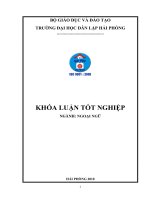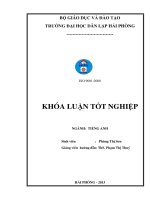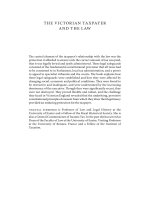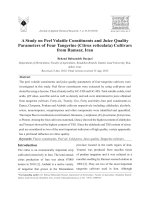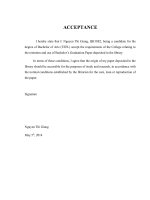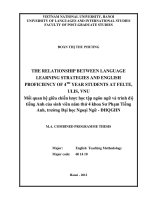Teacher student interaction and students speaking a study on listening – speaking classes with first year students at FELTE – ULIS VNU
Bạn đang xem bản rút gọn của tài liệu. Xem và tải ngay bản đầy đủ của tài liệu tại đây (855.79 KB, 102 trang )
VIETNAM NATIONAL UNIVERSITY
UNIVERSITY OF LANGUAGES AND INTERNATIONAL STUDIES
FACULTY OF POST - GRADUATE STUDIES
ĐỖ THỊ THANH DUNG
TEACHER-STUDENT INTERACTION
AND STUDENTS’ SPEAKING:
A STUDY ON LISTENING – SPEAKING CLASSES
WITH FIRST YEAR STUDENTS AT FELTE – ULIS - VNU
Tương tác giữa giáo viên – sinh viên
và kỹ năng nói của sinh viên năm thứ nhất
trong các buổi học Nghe – Nói tại
Khoa sư phạm Tiếng Anh – Đại học Ngoại ngữ - ĐHQGHN
M.A. MINOR PROGRAMME THESIS
Field: English Teaching Methodology
Code: 60140111
HANOI, 2016
VIETNAM NATIONAL UNIVERSITY
UNIVERSITY OF LANGUAGES AND INTERNATIONAL STUDIES
FACULTY OF POST-GRADUATE STUDIES
ĐỖ THỊ THANH DUNG
TEACHER-STUDENT INTERACTION
AND STUDENTS’ SPEAKING:
A STUDY ON LISTENING – SPEAKING CLASSES
WITH FIRST YEAR STUDENTS AT FELTE – ULIS - VNU
Tương tác giữa giáo viên – sinh viên
và kỹ năng nói của sinh viên năm thứ nhất
trong các buổi học Nghe – Nói tại
Khoa sư phạm Tiếng Anh – Đại học Ngoại ngữ - ĐHQGHN
M.A. MINOR PROGRAMME THESIS
Field: English Teaching Methodology
Code: 60140111
Supervisor: Assoc. Prof. Le Van Canh
HANOI, 2016
DECLARATION
I hereby certify that the thesis entitled “Teacher-student interaction and
students’ speaking: A study on listening – speaking classes with first year
students at FELTE – ULIS - VNU” is the result of my own research for the
Degree of Master of Arts at the University of Languages and International Studies,
Viet Nam National University. This thesis has not been previously submitted for
any other degrees. The work was done under the guidance of Associate Professor
Le Van Canh, at the University of Languages and International Studies.
Hanoi, June 2016
Đỗ Thị Thanh Dung
i
ACKNOWLEDGEMENTS
I would like to express the deepest gratitude to my supervisor, Associate
Professor Doctor Le Van Canh for his encouragement, supervision and support all
along the course of research. This paper would not have been accomplished without
his expert, constant and valuable guidance and criticism.
My special thanks also go to my colleagues and students at Division 1,
Faculty of English Language and Teaching Education, ULIS – VNU for their
enthusiastic participation during the process of data collection.
Finally, I would also like to express my sincere thank and love to my family
who gave me time and encouragement to overcome all obstacles during the
completion of this study.
ii
ABSTRACT
Due to its significant influence on learners' linguistic skills, classroom
interaction has been widely discussed by researchers of the field. This present
research aims to present an analysis of teacher-learner in-class interaction at
speaking-listening classes in the context of Vietnam. Interaction patterns, teachers‟
question and feedback and learners‟ talk are put into investigation. The participants
include 75 first year students and three teachers at Faculty of English Language
Teaching Education, University of Languages and International Studies. Data is
collected by classroom observation with audio-taping and field notes. After
transcripts are produced, interviews with three teachers and six students are
implemented to obtain more information. Interaction patterns are categorized,
different aspects of teacher talk and learner talk are analyzed according to
recognized frameworks. The result demonstrates that the structure of classroom
interactional mechanism is characterized by Initiation-Response-Follow up pattern,
in which most of the first and the third moves are taken by teachers. Teachers‟
questioning creates many opportunities for learners to produce output, whereas their
feedback sometimes interrupts learners‟ flow of talk. Although students do not take
initiatives to make questions, they fully participate in discussions. Pedagogical
recommendations and propositions for future fields of research are offered at the
end of the study.
iii
LIST OF ABRREVIATIONS
CLT:
Communicative Language Teaching
EFL:
English as a Foreign Language
ELT:
English Language Teaching
DQ:
Display questions
RQ:
Referential questions
FELTE:
Faculty of English Language Teaching and Education
FL:
Foreign language
L2:
Second Language
ULIS:
University of Languages and International Studies
TL:
Target Language
VNU:
Vietnam National University
iv
LIST OF FIGURES
ACKNOWLEDGEMENTS .............................................................................. ii
PART A: INTRODUCTION ............................................................................ 1
PART B: DEVELOPMENT ............................................................................. 5
Figure 1. Time spent on major episodes in a roughly 60-minute lesson ........ 34
Figure 2. Patterns used in Teacher-Student Interaction .................................. 37
Figure 3. Number of turns students speak in exchanges with Teacher .......... 38
Figure 4. Initiating Questions.......................................................................... 39
Figure 5. Teacher's Feedback .......................................................................... 43
Figure 6. Teacher's Follow-up ........................................................................ 45
Figure 7. Lexical density and Mean of Responses to Display questions and
Referential questions ....................................................................................... 56
v
TABLE OF CONTENTS
DECLARATION ............................................................................................... i
ACKNOWLEDGEMENTS .............................................................................. ii
ABSTRACT ..................................................................................................... iii
LIST OF ABRREVIATIONS .......................................................................... iv
LIST OF FIGURES........................................................................................... v
TABLE OF CONTENTS ................................................................................. vi
PART A: INTRODUCTION ............................................................................ 1
1. Introduction ........................................................................................... 1
2. Problem Statement and Rationale ......................................................... 2
3. Objectives and Significance .................................................................. 3
PART B: DEVELOPMENT ............................................................................. 5
CHAPTER ONE: LITERATURE REVIEW .................................................... 5
1.1. Classroom Interaction: A definition ................................................... 5
1.2. The role of interaction in second language learning .......................... 5
1.3. Theoretical perspectives on classroom interaction ............................ 6
1.3.1. The cognitive interactionist tradition .............................................. 6
1.3.2. The sociocultural theory tradition ................................................. 10
1.4. Approaches to studying classroom interaction ................................ 11
1.4.1. Discourse analysis approaches ...................................................... 11
1.4.2. Conversation analysis approaches ................................................ 13
vi
1.5. Types of classroom interaction ........................................................ 15
1.5.1. Teacher - student interaction ......................................................... 15
1.5.2. Student - student interaction ......................................................... 16
1.6. Teacher Talk ..................................................................................... 17
1.6.1. Teacher Questioning ..................................................................... 17
1.5.2. Teacher‟s Feedback....................................................................... 19
1.6. Interaction patterns ........................................................................... 20
1.7. Learner talk....................................................................................... 23
1.8. Turn taking ....................................................................................... 24
CHAPTER TWO: METHODOLOGY ........................................................... 27
2.1. Context and Participants ................................................................... 27
2.2. Methodology .................................................................................... 29
2.3. Data Collection Instruments ............................................................. 29
2.4. Data Collection Procedure ............................................................... 30
2.5. Data analysis instruments ................................................................. 31
CHAPTER THREE: FINDINGS .................................................................... 34
3.1. Episodes ............................................................................................ 34
3.2. Interactional Patterns ........................................................................ 36
3.3. Teacher‟s Initiating Questions ......................................................... 39
3.4. Teachers' Feedback........................................................................... 43
3.5. Learner Talk ..................................................................................... 55
CHAPTER FOUR: DISCUSSION ................................................................. 65
vii
4.1. Interactional patterns ........................................................................ 65
4.2. Teachers‟ Initiating Questions ......................................................... 66
4.3. Teachers‟ Feedback .......................................................................... 67
4.4. Learner Talk ..................................................................................... 69
PART C: CONCLUSION ............................................................................... 72
REFERENCES ................................................................................................ 77
APPENDIXES ................................................................................................... I
viii
PART A: INTRODUCTION
1. Introduction
The influence of classroom interaction on students‟ learning in the context of
second/foreign language education has been researched from different theoretical
perspectives (e.g. Allwright ,1984). It has been documented in the literature that
classroom interaction is noticeably central to all classroom activities that make up
classroom practices (e.g. Walsh, 2011). For example, River (1987) states that
students have opportunities to practice their possess of the target language and
increase their language store. This is also confirmed in Mackey‟s research (1999)
about the relationship between interaction and language acquisition. The
participation in the interaction could facilitate learning development. Furthermore,
Long (1990) asserts that language acquisition is the result of an interaction between
the learners‟ mental abilities and the linguistic environment.
For English foreign language learners, especially those are studying English
in a non-English speaking setting, classroom is often considered a prime
educational institution where they can practice the target language. In other words,
practicing English as a foreign language usually occurs inside the classroom. To put
it differently, students are rare to practice the target language outside the classroom.
Accordingly, classroom interaction is considered a vital means to master the
language and speaking skills in particular.
In English foreign language class, the teacher‟s role is crucial since teachers
integrate every element under their role to create or facilitate an appropriate
learning environment in the classroom. They can foster classroom conditions that
encourage or restrict successful student participation (Hall, 1998). In fact, the
teacher is expected to initiate, manage, and keep conversation and communication
going. To involve students in classroom interaction, asking questions and giving
feedback to learners' responses are two of effective measures that teachers could
utilize.
1
Obviously, learners also play an integral role in their language acquisition.
Swain (1988) considers that students are learning while participating in classroom
interaction. They need to use the language resource they have already acquired to
produce "comprehensible output". By interacting verbally, learners manage to use
diverse strategies as speaking in a low pace, repeating while clarifying their view
points throughout paraphrasing to make themselves understood by their colleagues
and teacher (Chadia, 2011).
In order to improve teaching and learning, apart from devoting a
considerable amount of time to teaching methods and to subject knowledge,
teachers are suggested to be well aware of the significance of teacher talk, the
process of interaction and their nexus with learning. They, in practice, need to
stimulate students to interact verbally and arouse their thinking by asking genuine
questions. Beforehand, it is essential to make students comprehend how important
and significant discussing in the process of learning is. On the other hand, students
are supposed and expected to provide contributions of their own. As a result,
teachers and learners work collectively when dealing with language tasks, listening
to one another in a respectful way, and valuing others' contribution.
2. Problem Statement and Rationale
Despite a large body of research on classroom interaction, the issue remained
under-researched in the context of Vietnam. Some of studies are Classroom
interaction in a Vietnamese university English class (Dung, 2004), Teacher
questioning strategies and classroom interaction in Ly Thai To school (Thu, 2008).
These research tends to concentrate on effects of teachers‟ questioning behaviors,
without examining teachers‟ feedback as an influencing factor on learners‟ talk.
Students‟ use of language also receives less investigation than expected. In addition,
while there has been evidence that students could learn the target language through
interaction in classroom, it has not been known properly to what extent different
kinds of interaction lead to language learning. Another drawback could be found in
2
recent studies such as Kouicem's in 2009, Bouraya‟s in 2011 is the single source of
data from students‟ questionnaire and/or teachers‟ interview to examine the relation
of classroom interaction and learners' speaking. Without audio-recorded or videotaped lessons, this data collecting instrument might not provide adequate
information and evidence to reveal the concerned topic.
Motivated by the current situation, the present study proposes to investigate
classroom interaction with a larger focus by utilizing various data collection and
analysis instruments. To be more specific, it is to examine the nexus between
teacher – student interaction and its effects on students‟ speaking.
3. Objectives and Significance
The current study was conducted at the Faculty of English Language
Teaching Education - University of Languages and International Studies. While the
overall aim of the study was to explore classroom interaction patterns in speakinglistening lessons and the extent to which those interaction patterns engaged the
students in practicing speaking English, it was designed to achieve the following
objectives:
1. to identify the teachers‟ question and feedback as a form of interaction that
involves the students into the process of negotiation of meaning;
2. to identify the degree of students‟ engagement in classroom interaction as
the result of the teachers‟ approaches to classroom interaction.
In order to achieve the above aim and objectives, the study seeks answers for
the following questions:
1. What are features of teacher - student interactions in the lessons?
2. To what extent do teacher - student interactions influence students' speaking?
The findings of the present study hopefully enrich reference in the area by
providing more empirical evidence. More importantly, the results of this study
could contribute to the teacher‟s awareness of their present use of the target
3
language, its critical role and preparing the ground for a more reasoned language
use in class. To put it differently, teachers are encouraged to adjust the appropriate
language use in class when they understand it more comprehensively. This also
means that learners can benefit, for instance, by being given more interactive
learning opportunities or being provided effective feedback. Holding no less
importance, teacher-trainers may take classroom interaction analysis into
consideration while attending teacher-training courses and doing their practicum.
Last but not least, language teaching methodology researchers and teachers might
conduct further research in the area to advance English language teaching methods
and techniques in the EFL classroom.
4
PART B: DEVELOPMENT
CHAPTER ONE: LITERATURE REVIEW
1.1. Classroom Interaction: A definition
Interaction is the collaborative exchange of thoughts, feelings or ideas
between two or more people, leading to a mutual effect on each other as River
(1987). In general, interaction consists of two types: non-verbal interaction and
verbal interaction. Non-verbal interaction is related to behavioral responses. In
classroom, participants interact nonverbally through their behaviors such as head
nodding, hand raising, body gestures, and eye contact. Verbal interaction, on the
contrary, contains written interaction and oral interaction. Written interaction is the
style of interaction in which students write out their ideas, thoughts. It means they
interact with others through written words, documents and so forth. By contrast,
oral interaction implies that teachers and students interact by asking and answering
questions, making comments, and taking part in discussions. These two types of
interaction are summarized by Robinson (1994): “Interaction is the process
referring to “face-to-face” action. It can be either verbal channeled through written
or spoken words, or non-verbal, channeled through tough, proximity, eye-contact,
facial expressions, gesturing, etc.” Classroom interaction, according to Dagarin
(2004), is an interaction occurring in the learning and teaching process between
teacher and students and among students in the classroom. This definition is used to
guide this study.
1.2. The role of interaction in second language learning
According to River (1987), students can increase their language store
through interaction because they can use all their possess of the language. In a
language classroom, the target language is not only the means by which learning is
accomplished but also the pedagogical objective (Swain, 1997). In other word,
5
within the classroom context, instructors and students mutually construct
knowledge of language and simultaneously create opportunities for language
practice. Tsui (1995) believes that accomplishing communicative tasks, listening to
teacher's explanations and instructions, expressing one‟s point of views in arguing,
answering asked questions mean learning the TL. Students grasp language structure
and functions and then they put what they are acquiring into practice by using it in
classroom with their peers and teacher. Indeed, students are suggested to take
initiatives in the process of advancing their linguistic skill instead of being passive
consumers and recipients during the lesson. As Mackey (1999) finds out, those
learners involving in an interactional course all along their practice of the targeted
structure, perform better. Specifically, the language development of those students
who take more turns to practice the TL is faster compared to those learners being
reluctant to interact with their peers and teacher. Additionally, Hall & Walsh (2002)
state that instructors and students establish their roles and relationships through oral
interactions within the classroom. A teacher-centered or learner-centered
environment is partly determined by the way teachers and students communicate in
the classroom.
1.3. Theoretical perspectives on classroom interaction
Classroom interaction has been researched from two main theoretical
traditions: the cognitive interactionist tradition and the sociocultural theory
tradition. These two positions will be discussed briefly subsequently.
1.3.1. The cognitive interactionist tradition
Cognitive interactionist advocates believe that learning a second language
involves receiving comprehensible input, which is processed through negotiation of
meaning, before producing comprehensible output (Long, 1981).
In regard to the relationship between classroom interaction and second
language acquisition (SLA), two fundamental concepts - reception and production
should be taken into consideration. According to Ellis (1990), "reception-based
6
theories" of classroom interaction are centered on the idea that interaction takes part
in SLA via learners' comprehension and reception of the SL. "Production-based
theories", on the other hand, consider that SLA is strongly linked to learners'
attempt at producing the TL. While the former are well-presented by Krashen and
Long in their input theories in 1980s, the latter are more assimilated with Swain's
output theory in 1980s.
In language learning, input is defined as the language that learners hear or
receive, from which they can learn (Richards& Schmidt, 1992). As Krashen stated
in 1982, Input is seen not merely as a social and pedagogical aim; it is rather a
medium through which a great deal proportion of the TL is learnt. In other words,
language acquisition can take place when learners comprehend the input they are
exposed to. Krashen argues that the exposure to comprehensible TL input is in itself
sufficient to trigger acquisition (Richards & Renandya, 2002). Additionally,
incomprehensible input is not expected to cause learning to take place. From this
theoretical perspective, the main purpose of interactions between teacher and
learner is that one interlocutor feeds the other input. The consumer of this input
therefore acquires language by taking in the input that is given to her. In short,
interaction from this theoretical viewpoint functions as a way in which instructors
supply learners with ample amounts of comprehensible input.
Expanding Krashen‟s ideas of input, Long (1981) suggested that one way
interlocutors make input comprehensible is through a variety of interactional
modifications. One of the major points distinguishing Krashen's theory from Long's
one is that the latter believes that intentionally modified input is more beneficial for
acquisition than the pre-modified input as suggested by Krashen. When a learner
signals a lack of comprehension while interacting with the input provider, the
instructor is able to modify the way in which he is expressing an idea or naming an
object to provide input to the learner that the learner can understand. Some of these
modifications are themselves interactional in nature, such as confirmation and
comprehension checks, clarification requests, reformulations, topic-focused and
7
elaborated questions, and recasts (Long, 1981). As a result of the modifications, the
learner is better able to comprehend the input, which promotes L2 acquisition.
Krashen and Long's interaction hypotheses were reviewed by Thoms in 2008
that they viewed interaction as to transmit language knowledge or competence. Put
it in plain words, interaction is viewed as a necessary means to an end. It is
primarily conceptualized as a tool that facilitates the process of language learning
and culminates in the end product of acquisition. Johnson (1995) considers that in
presenting his hypothesis, Krashen overstresses the role played by comprehensible
input which focuses on meaning rather than form. Conversely to what Krashen
emphasized; Pica & Young and Doughty (1987) (cited in Ellis& Barkhuizen, 2005)
view that comprehension can be achieved when input is intentionally derived and
modified rather than when being pre-modified.
The aforementioned input theoretical views have given prominence to input
which may not provide a comprehensive understanding of the role of interaction in
the process of SLA. In other words, interaction as understood from the above
perspectives is closely associated with the delivery of input and assumes that
language learning is a result or product of interaction between interlocutors. In fact,
one of the criticism addressed to Long Interaction Hypothesis is suggested by Swain
(1985) (cited in Chadia, 2011). Swain accentuates that Long and Krashen claim
strongly that acquisition arises relatively entirely through access to comprehensible
input while they fail to admit the value of comprehensive output.
Swain views that output is crucial in several ways. For instance, when a kind
of communication breakdown occurs between interlocutions in the classroom,
learners would do their best to make themselves comprehended using different
means and strategies to convey messages precisely, coherently and appropriately
(Ellis, 1985). In her output hypothesis (1985), Swain does not neglect the
significance of input in enhancing the TL acquisition but she stresses the fact that
learners must be offered the chance to produce the TL so as to become fluent
speakers: "Negotiating meaning needs to incorporate the notion of being pushed
8
toward the delivery of a message." (Swain, 2005). In her point of view, language
production, namely output, is a kind of TL production that leads to and enhances
learners' fluency. More significantly, she considers that output has the function of
enhancing noticing as it has a triggering function. While language learners try to
produce TL, whether in written or oral form, they may simultaneously notice that
they have a problem of not knowing how to say the idea or the meaning they want to
convey due to lack of vocabulary items or the ignorance of the syntactic
structure…etc. In these cases, learners become conscious of their linguistic actual
knowledge. Observing the existence of a hole in their interlanguage, learners are then
going to use different strategies to fill in these gaps using dictionaries, grammar
books, asking for help from their peers or teachers or trying to concentrate more on
the input to get what they want. To Swain, noticing the gap in their knowledge about
the TL, and while producing this latter, learners are actually making hypotheses about
it and testing them simultaneously. Especially when they receive negative feedback
from the part of their teacher; students then will do all their best to modify their
output, so as to make it fit the TL structures (Swain, 2000).
Yet it is paramount to note that producing output is not a trouble -free task
and certainly it needs huge efforts and will from the part of learners. As far as the
kind of output which should be generated by SL/FL learners, Swain believes that
students are preferred to initiate by themselves output production rather than
responding. That is to say, SL learners need to participate and interact actively; they
should not be restricted by interlocutors in the discourse. In fact, the more students
feel free to initiate participation, take turn, take risk, and choose the topic, the more
their verbal interaction would be beneficial and richer.
From their part, Hall &Verplaetse (2000) regard the fact of being exposed to
comprehensible input as a factor alone is not sufficient. For SL/FL learners are in
need to produce output so as to "push forward the wheels" of their TL in classroom.
According to them, Input hypotheses as introduced by Krashen and Long and the
output as exposed by Swain should not be put on converse position. Instead, they
9
need to complement each other.
In short, the cognitive interactionist tradition views interaction as supporting
the individual‟s knowledge construction, since it helps to activate existing knowledge
of the individuals. The teacher‟s role is to make the input comprehensible, provide
opportunities for students to produce output, and to provide appropriate feedback on
the students‟ output.
1.3.2. The sociocultural theory tradition
Advocates of the sociocultural theory tradition rely on Vygotsky‟s (1978)
work, which emphasizes the role of social interaction in mental development. Thus,
classroom interaction is viewed as a social activity emerging in open public
communication. Walsh (2006) confirms that social interaction and context are not
separated from the learning situation. Central to the sociocultural theory is
Vygotsky‟s (1978) notion of zone of proximal development.
In order to produce the targeted language in class, learners need to be
exposed to input which is comprehensible and little beyond their current knowledge
about the TL for after all input is the model of the TL. This is one of the foremost
concepts of Vygotsky "zone of proximal development". It was defined by Vygotsky
(1978) as the distance between the actual development level as determined by
independent problem solving and the level of potential guidance with more capable
individuals. As a sociocultural theorist, he stresses the fact that learning is a social
activity more than being an individual one. He particularly highlights that the
assistance offered to SL learners by more experts should neither be too far beyond
their actual knowledge about the TL so as to ensure access to the structure of that
language. Nor it should be too easy to enhance learners' mental abilities. In short, in
learning first, second or foreign one, teachers should not teach that language as an
object. They should rather enable their learners participate in dialogic activities
using that language as a tool to enhance their oral performance (Lantolf, 2005).
Having the same opinion, Krashen maintains that language acquisition can
be achieved when learners are exposed to language input whose structure is beyond
10
their current level of language competence. This is recognized as "i+1 hypothesis",
while the “i” stands for the actual level of learners' language expertise, the “1”
symbolizes language function and linguistic forms which are beyond their level. Put
it more simply, teachers whose speech might be a source of the input provided for
students, must be acquainted with his learners' level in language proficiency. Basing
on that, they try to provide a more slightly complex input so the input can be
understood and comprehensible to them. In doing so, teachers are, in reality,
creating opportunities for their learners to interact verbally and communicate more
to understand and assimilate the input they are exposed to.
The major difference between the cognitive interactionist and sociocultural
theories is seen not only in whether they acknowledge the significance of
interaction and social contexts in learning, but in the definition of the relationship
between interaction and learning as well. For example, the cognitive interactionist
theory perceives interaction as an element that has an effect on learning. Learning is
recognized as a variable that can be explained by the features of interaction and the
individual‟s social background. In the sociocultural theory, however, interaction and
context are not separated from one another. The individual and his or her
environment are viewed in a dialectical relationship. As a result, the individual‟s
action is seen as part of the social construction of shared understanding (Walsh,
2006; 2011). This theoretical position is adopted in this study.
1.4. Approaches to studying classroom interaction
1.4.1. Discourse analysis approaches
Discourse analysis is the study of spoken or written texts. Its focus is on words and
utterances above the level of sentence and its main aim is to look at the ways in
which words and phrases function in context. For example, the frequently used
„Could you turn to page 36?‟ might be interpreted as a request under DA. Other
utterances may be less easy to classify. The phrase „the window‟s open‟, when
11
uttered in a classroom, might function as a request (please close it), an explanation
(that‟s why it‟s so cold), a drill (everyone repeat), a definition (as a way of showing the
meaning of open).
As far as the methods used to analyzing CD are concerned, the earliest and most
well-known proponents of DA probably are Sinclair and Coulthard (1975) who,
following a structural-functional linguistic route to analysis, compiled a list of
twenty-two speech acts representing the verbal behaviours of both teachers and
students participating in primary classroom communication. Perhaps the most
important contribution of Sinclair and Coulthard to our understandings of classroom
discourse is their realisation that most classroom discourse follows an IR(F)
structure. For every move made by a student, teachers typically make two. Thus, we
can say that most teaching exchanges follow an IRF structure, made up of three
moves, with each move containing one or more speech acts. Not only does this help
to confirm the fact that teachers do speak much more than students in most
classrooms, it also demonstrates how teachers often control the discourse. one
utterance can.
One of the main limitations of the Sinclair and Coulthard system is that it was
derived from data recorded in „traditional‟ primary school classrooms during the
1960s. In this context, and by the authors‟ own admission, it was possible to
identify very clear status and power relations between teachers and learners.
Consequently, the ensuing discourse had a very clear structure that was largely
dominated by question and answer routines. In the contemporary L2 classroom, where
there is, arguably, far more equality and partnership in the teaching–learning
process, it is doubtful whether the framework could adequately describe the
structure
of
classroom
communication.
To summarise, it can be said that DA approaches are both descriptive and
prescriptive and attempt to categorise naturally occurring patterns of interaction and
account for them by reference to a discourse hierarchy. The starting point is
12
structural-functional linguistics: classroom data are analysed according to their
structural patterning and function. For example, the interrogative structure „What
time does this lesson end?‟ could be interpreted as a request for information, an
admonishment, a prompt or cue. Any attempt to analyse classroom data using a DA
approach, therefore, involves some simplification and reduction. Matching
utterances to categories may be problematic owing to the issues of multifunctionality and the absence of a direct relationship between form and function. In
general, DA approaches fail to take account of the subtler forces at work such as role
relations, context and sociolinguistic norms that have to be obeyed. In short, a DA
treatment fails to adequately account for the dynamic nature of classroom
interaction and the fact that it is socially constructed by its participants. By the same
token, DA approaches do not adequately account for the range of contexts in
operation in a lesson and for the link between pedagogic purpose and language use.
1.4.2. Conversation analysis approaches
The origins of conversation analysis (CA) come from an interest in the function of
language as a means for social interaction (Sacks, Schegloff and Jefferson 1974).
CA is based on the premise that social contexts are not static but are constantly
being formed by the participants through their use of language and the ways in
which turn-taking, openings and closures, sequencing of acts, and so on are locally
managed. Interaction is examined in relation to meaning and context; the way in
which actions are sequenced is central to the process.
The relevance of a CA approach to the L2 classroom context is not difficult to
perceive. CA attempts to account for the practices at work that enable participants
in a conversation to make sense of the interaction and contribute to it. There are
clear parallels: classroom talk is made up of many participants, and there have to be
smooth transitions and clearly defined expectations if meanings are to be made
explicit. Possibly the most significant role of CA is to interpret from the data rather
than impose pre-determined structural or functional categories.
13
The main features of a CA approach to analysing L2 classroom interaction are
summarised. Firstly, the aim of CA is to account for the structural organisation of
the interaction as determined by the participants. There should be no attempt to „fit‟
the data to preconceived categories. Secondly, the approach is strictly empirical. CA
forces the researcher to focus on the interaction patterns emerging from the data,
rather than relying on any preconceived notions which language practitioners may
bring to the data (Seedhouse 2004). Thirdly, the observer is seen as a „member‟ of
the interaction, trying to view the experience through the eyes of the participants.
The aim is to offer an emic (insider) perspective. Fourthly, Context is dynamic and
mutually constructed by the participants. Contexts are therefore constantly changing
as a lesson progresses and according to local demands and constraints. Lastly, the
analysis of the data is multi-layered. CA approaches emphasise both context and the
sequentiality of utterances. Because no one utterance is categorised in isolation and
because contributions are examined in sequence, a CA methodology is much betterequipped to interpret and account for the multi-layered structure of classroom
interaction.
However, it cannot be denied that CA approaches do have a number of limitations.
To begin with, some researchers criticise CA for being over selective. Snatches of
discourse and their ensuing commentaries may appear to have been selected
randomly with no attempt to evaluate their significance to the discourse as a whole.
Any selection of data may appear contrived or idealised in order to illustrate a
particular point with little attempt to relate them to the exchange as a whole.
Moreover, a more serious criticism of CA approaches is their inability to generalise
findings because they focus on one specific and very narrow context. While this
may be true of many qualitative research tools, it is particularly applicable to a CA
methodology owing to the centrality of context. That is not to say that contextspecific data are not valid or worthwhile; merely that they cannot be extended to
other contexts. This objection is countered, however, if we acknowledge that the
14
aim of classroom specific research is not so much to generalise as to promote
understanding and facilitate replication to another context. 456789
1.5. Types of classroom interaction
1.5.1. Teacher - student interaction
This type of interaction happens between the teacher and one learner or
many other learners. Teachers negotiate with students the content of the course,
asks questions, uses students' ideas, lectures, gives directions, criticizes or justifies
student talk responses. They allocate speaking turns to students by either specifying
who is to answer or by making it open to the whole class. These kinds of turnallocations have been referred as „personal solicit‟, if it is done by nominating or
using gestures; and „general solicit‟, when it is done by simply asking questions and
looking round the class (Allwright and Bailey, 1991, as cited in Tsui, 1995). A
common pattern found in classrooms is the one when the teacher starts off with a
general solicit but no student volunteers to take the turn, he resorts to a personal
solicit to sustain the interaction.
During teacher-learner interaction, the students seek to demonstrate their
speaking and listening skills in front of their teachers that is why teachers should
consider their way of interacting a crucial element in learning and teaching. Walsh
(2006) states that teachers who comprehend the strong nexus between TT,
interaction and learner's learning opportunities would afford efforts to promote
learning. According to Harmer (2009) teachers should focus on three things when
they talk with their students. Firstly, they must pay attention to the kind of the
language the students are able to understand, i.e. teachers should provide an output
that is comprehensible for the level of all the students. Secondly, the teachers must
think about what they will say to their students, hence the teacher speech is as a
resource for learners. Finally, teachers also have to identify the ways in which they
will speak such as the voice, tone and intonation.
15

